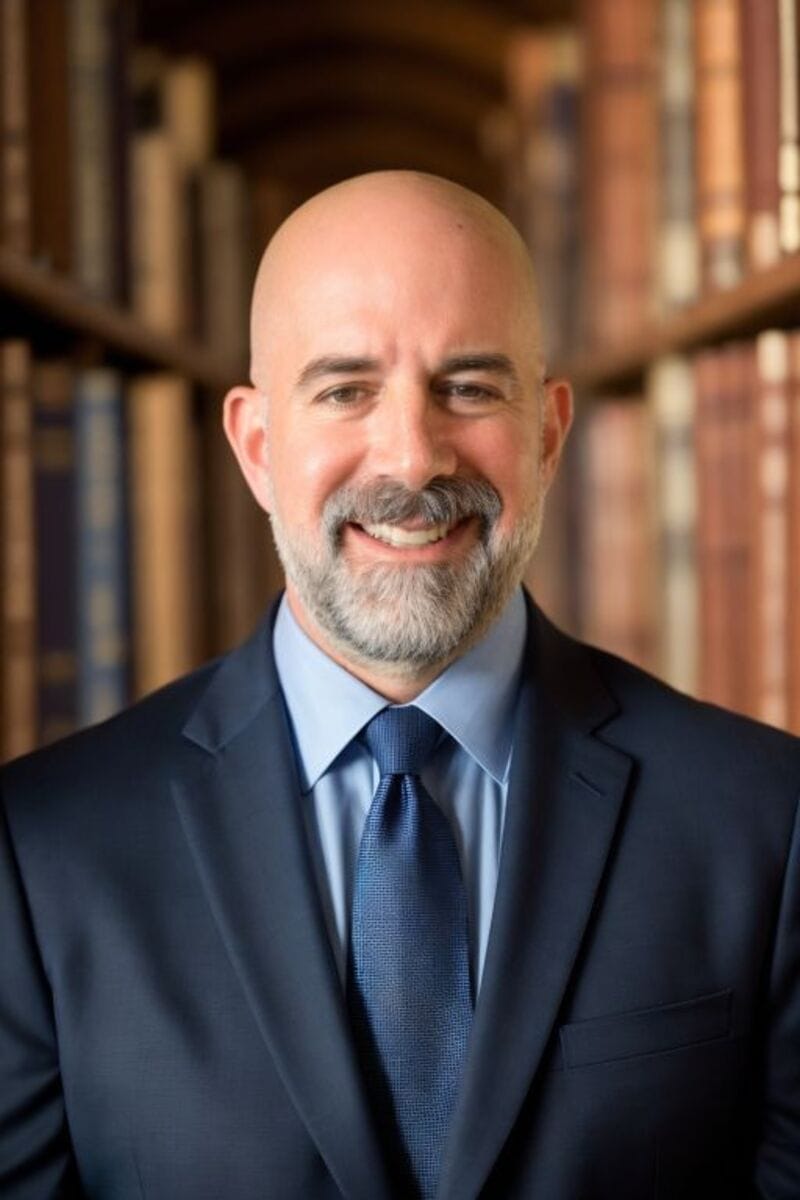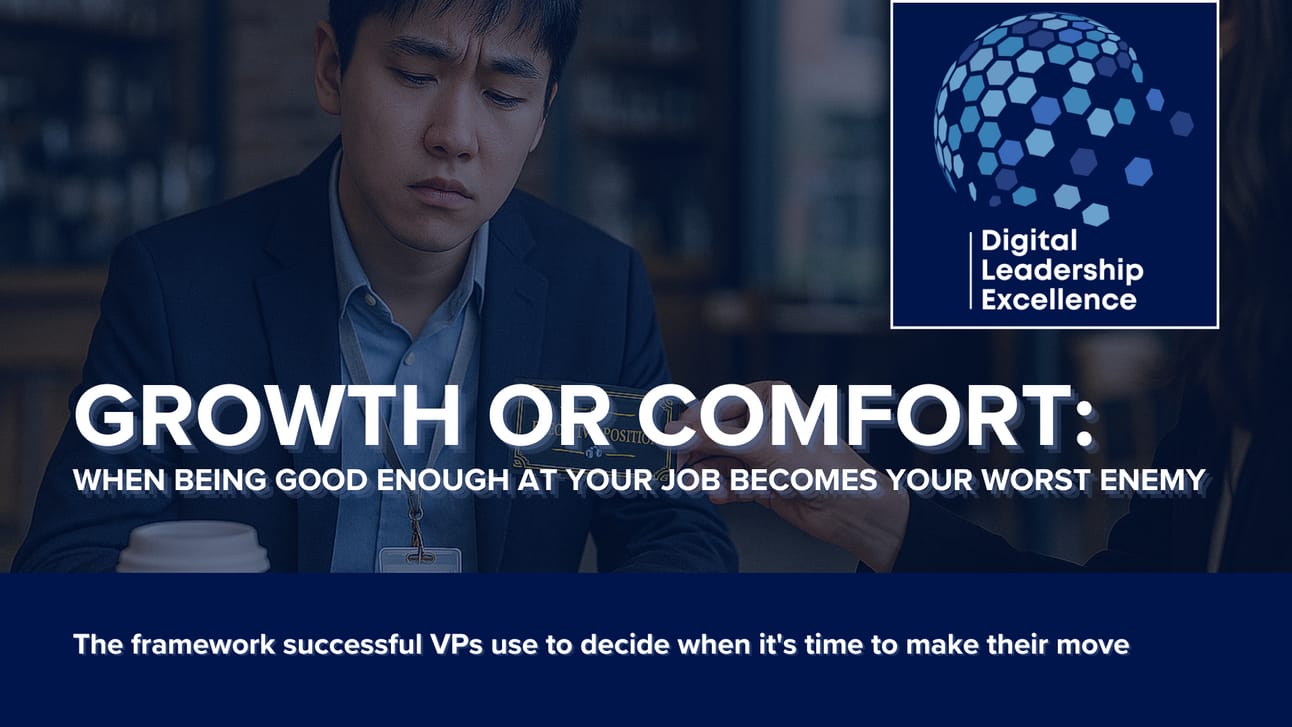Greetings, and welcome to Digital Leadership Excellence—your trusted weekly guide to excelling in tech leadership, delivering results, and thriving with clarity and purpose. In every issue, we provide insights into winning strategies, growth tactics, and practical solutions, designed to support both current and aspiring technology leaders navigating the ever-evolving digital world.
1.0 Introduction
There's a dangerous place every VP eventually finds themselves.
It's not failure. Failure is obvious. Failure forces action.
It's something far more insidious: Being good enough.
Good enough gets you comfortable.
Good enough makes you grateful for what you have.
Good enough convinces you that wanting more is somehow ungrateful or risky.
Good enough is a career killer.
And most executives don't see it coming until it's too late.
Here's the thing about comfort zones at the executive level - they don't feel like zones. They feel like achievements.
You worked HARD to get here. You earned this VP title. You've built a solid team, delivered consistent results, gained respect from peers.
You’ve arrived, right?
Wrong.
You've just entered the most dangerous phase of your career.
Because “arrived” is executive speak for “stopped growing.”

Let me paint you a picture that might feel uncomfortably familiar...
You're three years into your VP role. The learning curve flattened out somewhere around month eighteen. The challenges that used to excite you now feel routine. Team meetings cover the same ground week after week.
But here's what makes it dangerous:
You’re still successful by every external measure.
Bonuses hit your account. Performance reviews are solid. LinkedIn looks impressive. Your mom tells her friends about your fancy title.
So why does it feel like something’s dying inside?
Because being good enough isn't actually enough. Not for leaders who were meant to do transformational work.
The executives I work with who achieve legendary careers all share one realization:
The moment you stop growing, you start dying.
Not literally (though the existential dread can feel pretty real). But professionally? Absolutely.
Here's what happens when VPs get comfortable:
The market keeps evolving while you perfect yesterday's skills.
Other leaders take the risks you're avoiding and build the track records you could have built.
Opportunities that would have stretched and grown you go to executives who are still hungry for growth.
And slowly, imperceptibly, your potential begins to shrink.
You don't notice it day by day. It's like watching yourself age in the mirror - the changes are too gradual to see.
But one day you wake up and realize the gap between who you are and who you could have become is massive.
That’s when the “what if” questions start haunting you.
I see this pattern constantly. Talented VPs who chose safety over growth, comfort over challenge, good enough over great.
They’re not bad leaders. They’re just smaller versions of who they could have been.

The brutal truth?
Your comfort zone has an expiration date.
While you're maintaining the status quo, the world is changing around you. Technologies evolve. Leadership demands shift. Market dynamics transform.
The skills that made you successful yesterday won’t make you relevant tomorrow.
So here's the uncomfortable question every VP needs to answer:
Are you growing or are you just..aging?
Because if you're not actively growing, you're not maintaining your position.
You’re slowly losing it.
The VPs who build legendary careers understand this. They know that good enough is the enemy of great. They recognize that comfort is a trap disguised as success.
More importantly, they’ve learned to make decisions based on growth potential, not comfort level
Which brings us to the framework…
2.0 The Growth vs Comfort Decision Framework
After working with hundreds of technology executives, I've identified the exact process that successful VPs use to evaluate whether it's time to make their move.
It’s not about gut feelings or coin flips.

It's about honest assessment using four critical dimensions:
The Growth Trajectory Test
Ask yourself: "What percentage of my current role involves challenges I couldn't have handled two years ago?"
If the answer is less than 30%, you're in maintenance mode.
Maintenance mode feels safe. It feels successful. It also means you're practicing the same skills over and over while the world moves forward without you.
The leaders who become legends? They actively seek roles where a significant portion of their responsibilities stretch their current capabilities.
The Impact Amplification Audit
Question: "If I achieve everything possible in my current role, what's the maximum impact I can create?"
Now compare that to opportunities you're considering or avoiding.
If staying puts a ceiling on your impact, you’re choosing to play smaller than your potential.
Great leaders don't just want to be successful. They want their success to matter. They want to build things that didn't exist before. They want to solve problems that move entire industries forward.
You can't do that from a comfort zone.
The Future Relevance Reality Check
Here's the question that separates strategic thinkers from comfort seekers:
"Based on where my industry is heading, will my current skill development trajectory make me more valuable or less valuable in five years?"
This one hits different.
Because it forces you to confront whether your "successful" position is actually preparing you for tomorrow's challenges or just insulating you from today's discomfort.
The most successful VPs I know don't just think about their next role. They think about the role after that, and the one after that.
They build careers, not just collect titles.
The Regret Minimalization Filter
Final question: "When I'm 65 and looking back on my career, which will I regret more - taking a risk that didn't work out, or not taking a risk that could have been transformational?"
This is where it gets real.
Because most career regrets aren't about the moves you made. They're about the moves you didn't make.
The opportunities you passed because they felt too uncertain. The risks you avoided because you were "being smart." The chances you missed because staying felt easier.
Jeff Bezos calls this the "regret minimization framework."
And it's exactly how he decided to leave his comfortable Wall Street job to start some little company called Amazon.
3.0 Putting It All Together
Here's how successful VPs use this framework:
They score each dimension honestly. Not optimistically. Not pessimistically. Honestly.
If three out of four dimensions point toward growth requiring change, they know it's time to move.
If all four point that direction? They know they’re already late.
But here’s what separates the legends from everyone else:
They don't wait for the perfect opportunity.
They don't wait until staying becomes unbearable.
They don't wait until they're forced to change.
They move when growth demands it, even when comfort resists it.
Because they understand that choosing growth over comfort isn't just about career advancement.
It’s about honoring the potential they were given.
It’s about refusing to settle for good enough when great is possible.
It’s about building a legacy worth leaving.

So here's my challenge:
Take ten minutes this weekend and honestly assess yourself using this framework.
Don't rationalize. Don't make excuses. Don't convince yourself that good enough is actually enough.
Just be honest about where you are and where you could be.
Because your career isn't just about you.
It's about the problems you could solve, the teams you could build, the impact you could create, the legacy you could leave.
The world needs leaders who choose growth over comfort.
The question is: Will you be one of them?
Your move.


